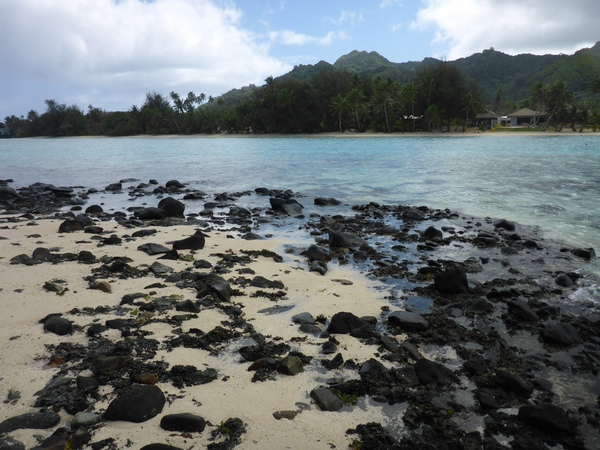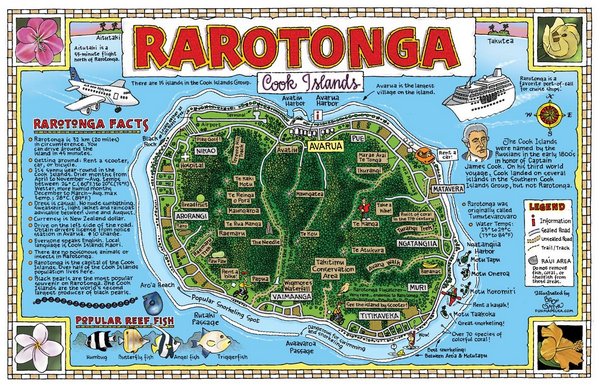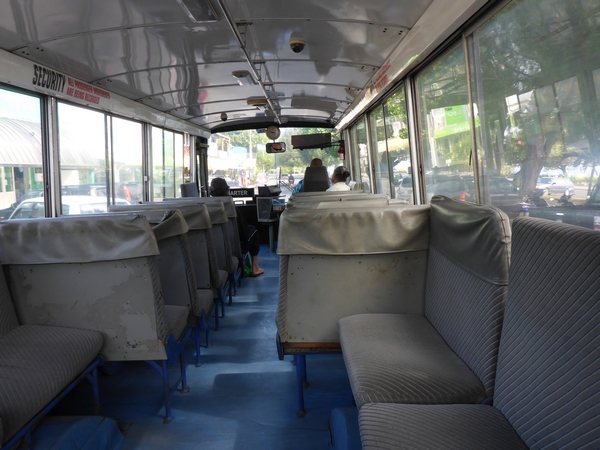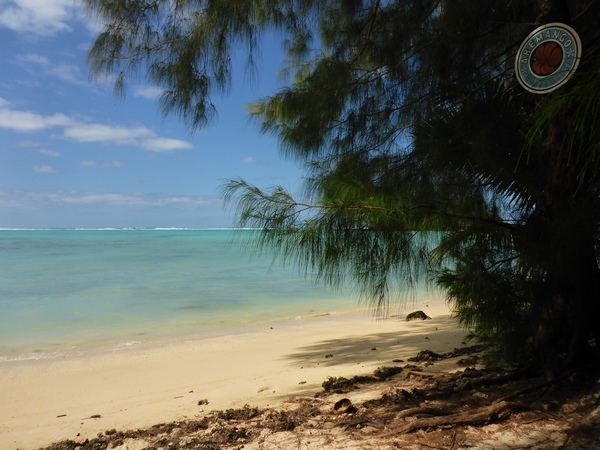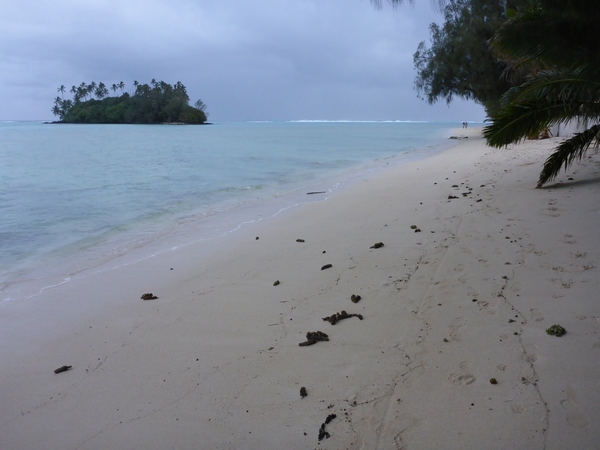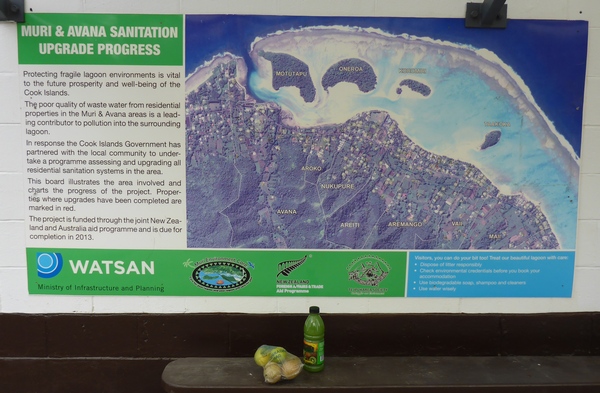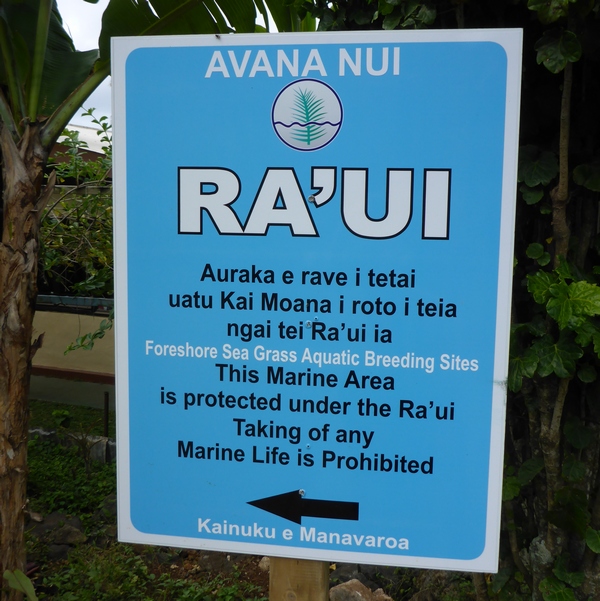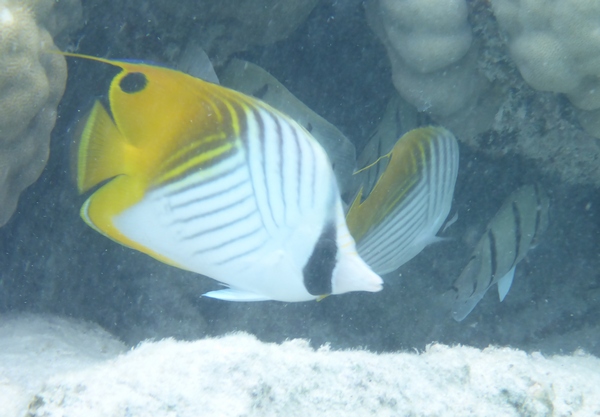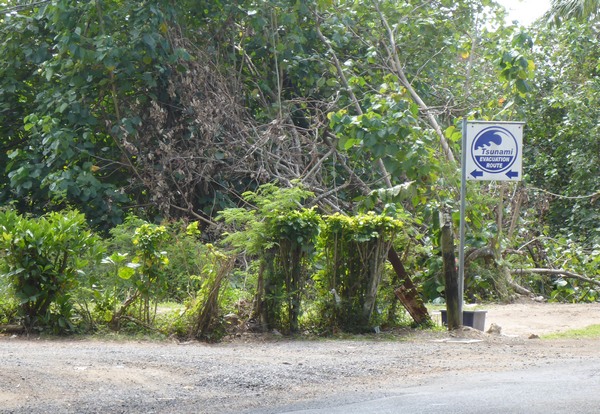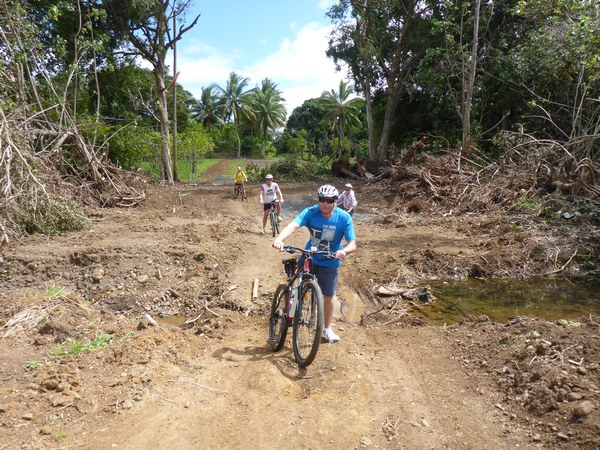(For new readers: if you’re just discovering this blog and you would like to read about my South Pacific travels from the beginning, you can click on this link to go to the first chapter: Travels in the Cook Islands.)
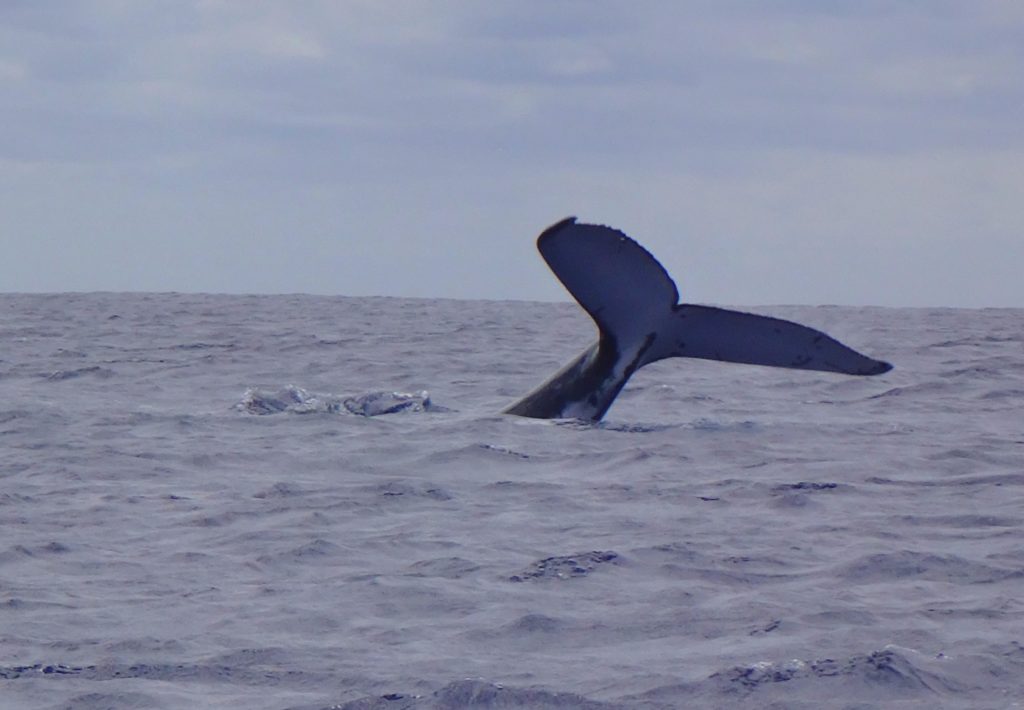
I’d got the hang of riding one of Matriki’s sturdy (albeit basic) bicycles, so on a hot and sunny Monday morning I ventured all the way to O’otu at the Aitutaki’s northeastern edge. I was tempted by the prospect of snorkeling in the gorgeous lagoon, but it was a sweltering day for cycling… And it turned out that visibility in the sandy waters at O’otu was limited at best. As if in sympathy with the murky visibility, the viewfinder of my underwater camera suddenly started to look a little foggy too… Before the camera gave up the ghost and stopped working.
Frantic efforts to revive the wretched gadget with freshwater rinsing, drying it, and then packing it in uncooked rice were totally unsuccessful. I contemplated spending the rest of my South Pacific travels unable to take photographs, which plunged me into a pit of despondency… My trip of a lifetime, and I wouldn’t be able to record any more of the amazing nature and landscapes and adventures I was encountering. (I know: first world problems, please don’t despise me.)
As I was sunk in angst, salvation came in the form of Trevor appearing at my beach hut to announce that he was heading out on a whale-spotting boat trip with a few of the Matriki guests that afternon, and did I want to come along? I stiffened my wobbly lip and replied in the affirmative, carpe-ing the diem as I realised for the umpteenth time that here I was in a gorgeous paradise with friendly folks and amazing wildlife, and a broken camera wasn’t the end of the world.
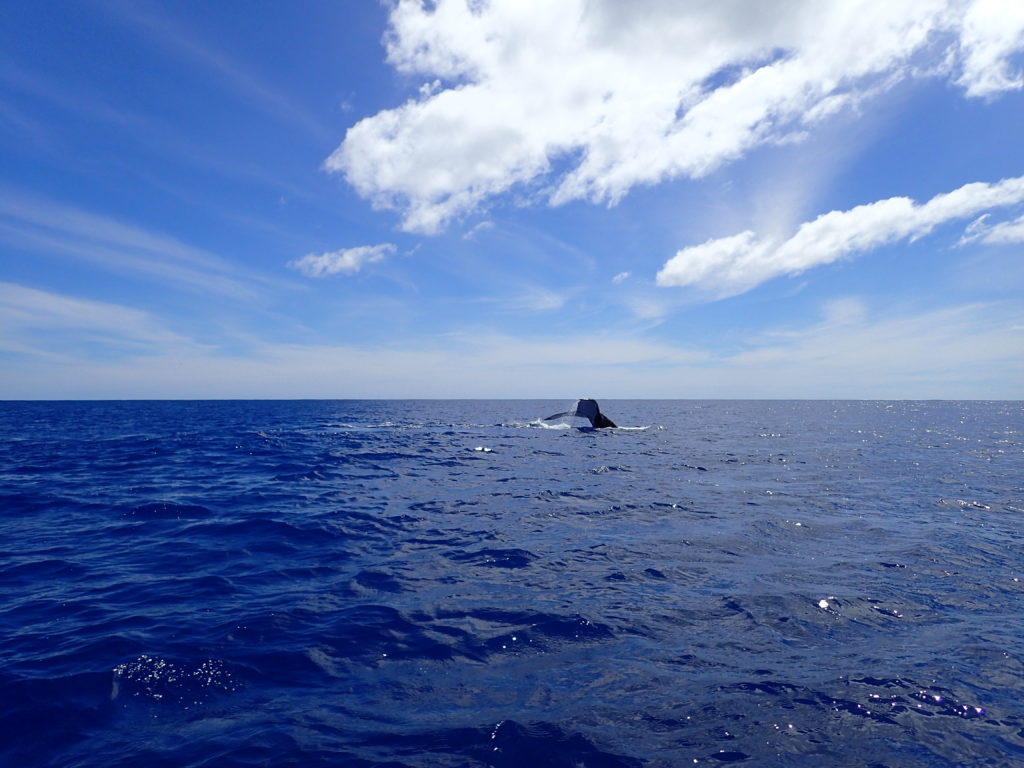
It’s only when we puttered out on Trevor’s little boat through Arutanga harbour and the reef passage into the open sea that the vastness of the South Pacific really hit me. As soon as you get outside the coral reef’s sheltering embrace, the ocean floor rapidly falls away to thousands of metres deep. My trip around the lagoon and motu with Puna a few days previously had been in sheltered shallow turquoise waters of five to ten metres: now we were bobbing over a Pacific swell, over midnight blue depths of over a thousand fathoms. Aitutaki dwindled and disappeared into the horizon, until all around us was nothing but ocean.
Trevor told us to keep our gaze trained on the surrounding seascape, to try to spot the spurt of exhaled breath or flick of tail flukes that would signal that humpback whales were in our vicinty. Although I’d heard reports from locals of occasional whale sightings offshore in the past few weeks, I was prepared for the disappointment of a no-show. Minutes stretched into nearly an hour with no sightings except a flying fish (local name māroro) Cheilopogon antoncichi – which was exciting enough to cheer me up!
Suddenly Nick, the thirteen year-old son of Kiwi tourists Tanya and Alex, shouted that he’d spotted something: Trevor affirmed the sighting and put the boat on a heading towards the far blue distance. And within half a minute all of us on the boat could see it too: the flick of a mighty tail as a whale dived towards the deeps.
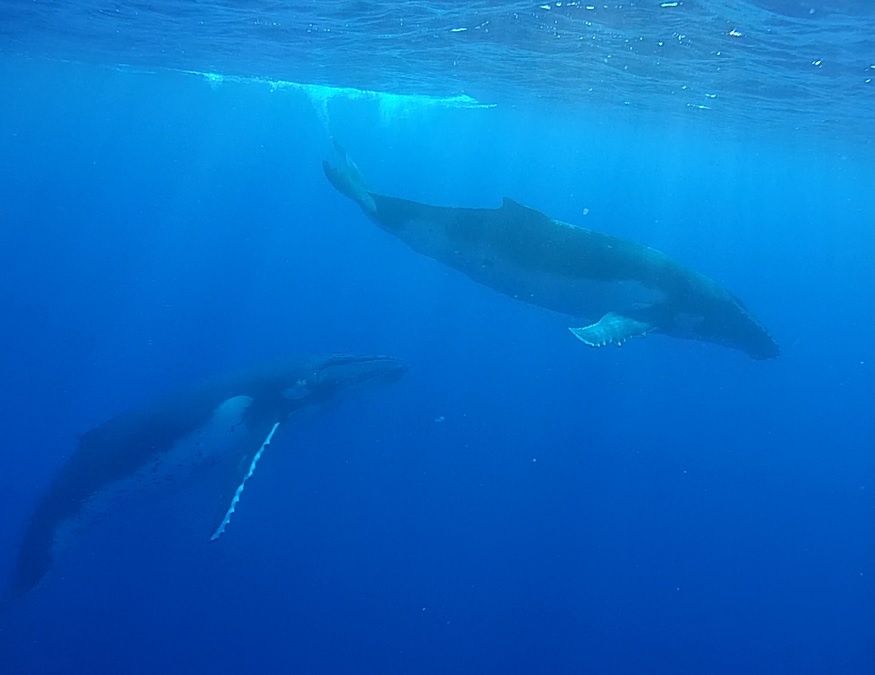
As soon as we were at a cautious but close enough distance, Trevor killed the boat engine and there was a frenzied flurry amongst some of us on board to scramble into mask and fins and slip over the side into the sea. As soon as I submerged into the water I could see two sub-adult humpbacks and a calf, gliding through the infinite blue sea-space with slow undulations of their tailfins. I was overwhelmed: feelings of awe, joy, nervousness, wonder. Swimming with humpbacks hadn’t been on my South Pacific wishlist yet here I was, sharing this underwater world with three massive marine kin.
Known locally as to‘orā, the humpback whale (Megaptera novaeangliae) is an uncommon migrant species which in 2008 was downlisted from ‘Vulnerable’ to ‘Least concern’ in conservation status by the IUCN. Estimated global population is 80,000 whales (just under two-thirds of the 125,000 humpbacks thought to have existed before commercial whaling began). The whales I was watching in the waters off Aitutaki weren’t feeding: they were living off body fat accumulated in their summer harvest of krill and small fish in the frigid but fertile waters of Antarctica. The calf with them would still be suckling milk and learning how to swim. As I hung below the surface of the Pacific I could hear the songs of the males, squeaks and whoops and long hoots that echoed through the aquamarine depths. (You can listen to them too in these two short film clips, recorded by German tourist Frank and kindly shared with me afterwards: a whale singing and two whales swimming and singing.) Only the male whales sing: and the whale songs here at Aitutaki are different to those sung at Tonga or elsewhere.
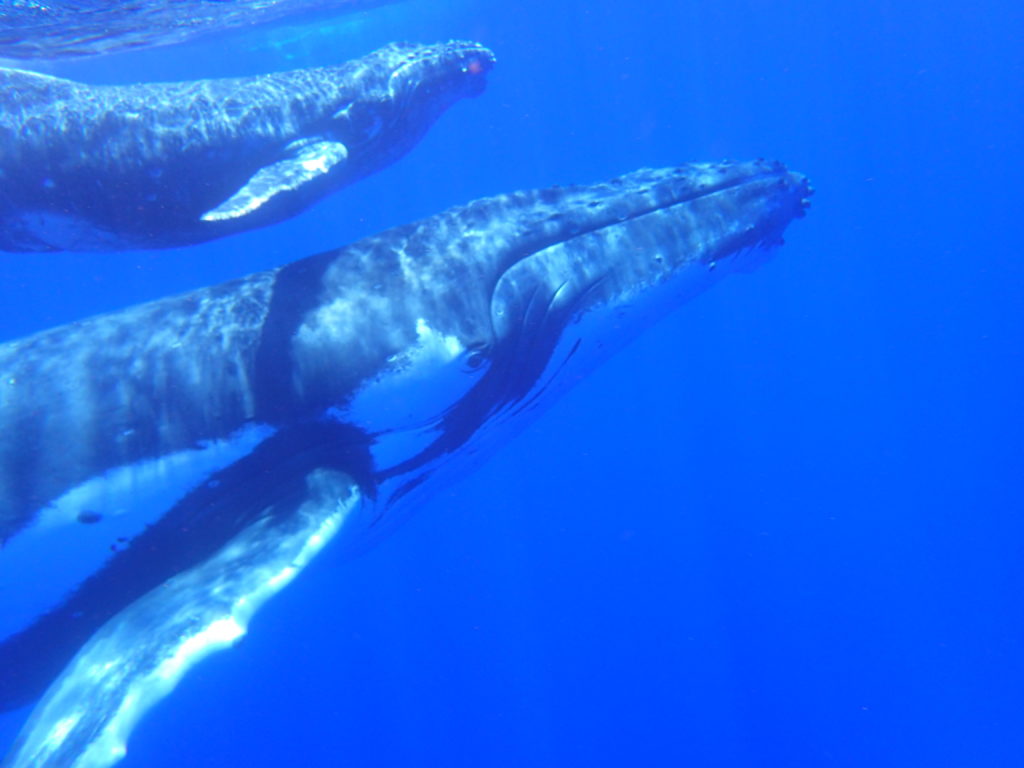
Two days after my magical visitation with the humpback whales I had another wonderful gift of a day. It began with Trevor and Tracey generously lending me a digital camera for my Punarei Aitutaki Cultural Tour; which then meant that I could take photos to record all the amazing things shared by local historian, archaeologist and champion of Aitutaki traditional culture, Ngaa (full name Ngaakaara Kita Taria Pureariki).
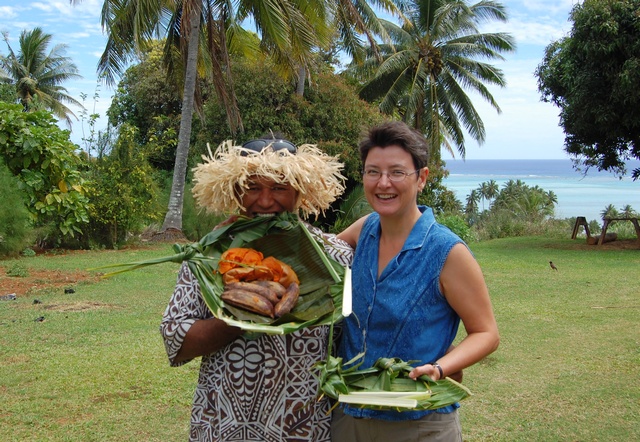
I liked Ngaa from the moment I met him, with his infectious enthusiasm, warm smile and determination to honour the rich heritage of his island’s history and people. Astonishingly, in the Cook Islands school history curriculum there is nothing about Cook Islands Maori culture, with the only history taught starting in the post-colonial era. Ngaa himself is working largely without support, to preserve and promote traditional Aitutaki culture. In a nation where the Christian church is central to most people’s lives and also to political and civic society, celebrating traditional culture is often seen as pagan, anti-Christian and wrong. Ngaa told me that sometimes he felt lonely in his work… But he knows he was born to do it.
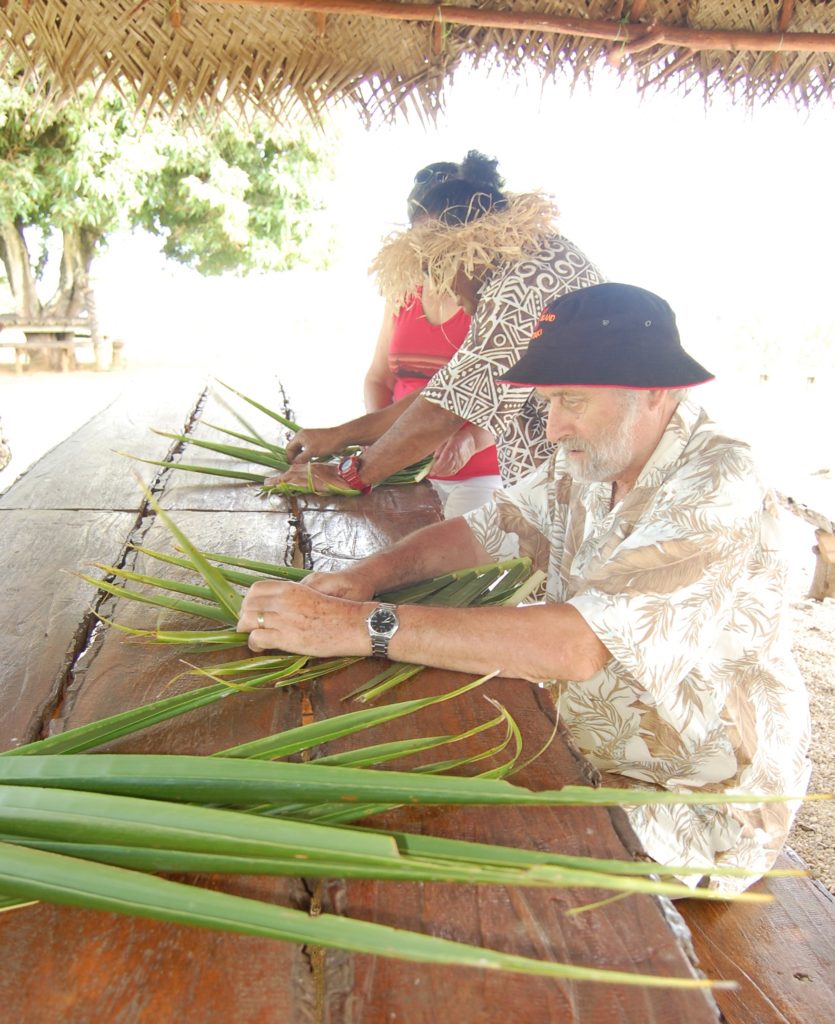
The day’s experience was hands-on, with Ngaa teaching us to make cooking mats and food bowls from woven coconut leaves; and how to cook our lunch in an umu (earth oven, with leaf-wrapped food cooked on fire-heated stones). On his family land at Punarei, Ngaa has recreated traditional Aitutaki houses with their steep pitched roofs (more cyclone-proof than modern dwellings).
The settlement of Polynesia and the Cook Islands is an evolving archaeological science, but it’s thought that from 1500 BC onwards the Lapita (early ancestors of Maori and Polynesians) travelled east and south from Papua New Guinea to populate what is now known as Polynesia. Over millenia the eastward migration continued, until the first peoples are believed to have settled on Aitutaki around 800-900 AD. Ngaa related how there are now twelve tribes on the island, with twelve sacred sites. Their history was kept alive by oral tradition, with women being the storytellers (possibly because the men were warriors who often died young).
When white Christian missionaries arrived on Aitutaki in the early 1800s they brought conveniences such as iron tools, sugar and kerosene… But they also forbade and devalued local culture, knowledge and traditions, systematically dismantling Aitutaki life. The colonisers carried infectious diseases with them such as leprosy and measles, to which the local people had little or no resistance.
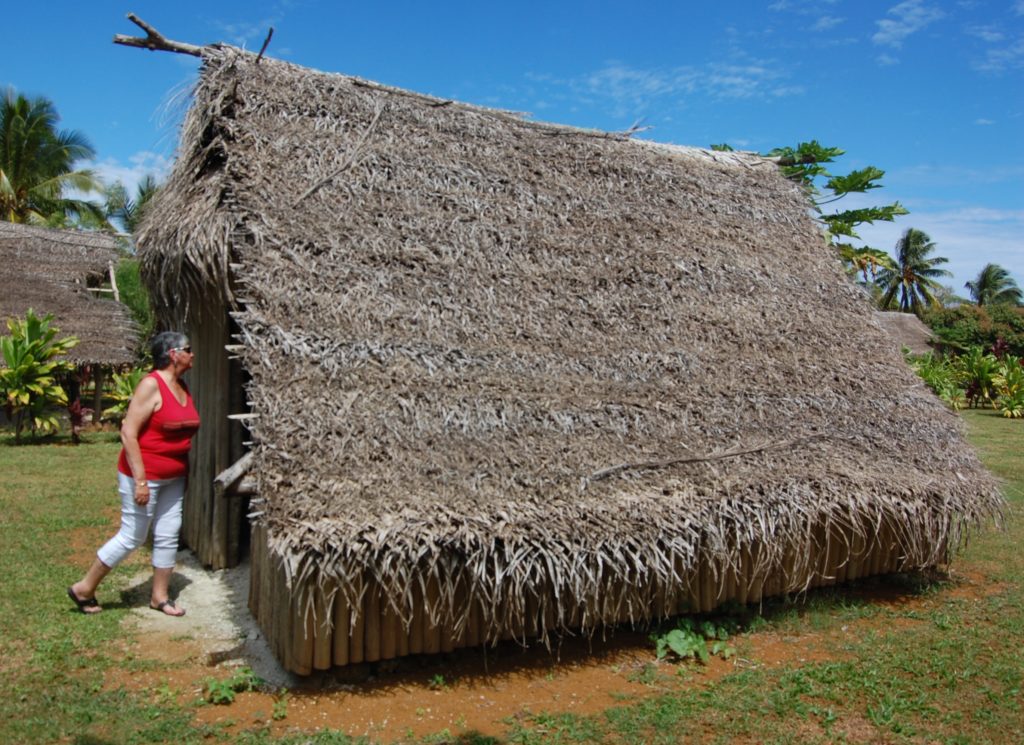
When these white Christian missionaries arrived in the Cook Islands, they regarded tiki – wood or stone carvings in humanoid form – as pagan idols, to be removed or destroyed. On other islands many were burned, but by chance a white trader saw the potential to make a quick profit and sold many Aitutaki tiki to collectors overseas. Thirty-one tiki figures were taken from Aitutaki in the 1820s, ending up in European collections. Ngaa has carved tiki inspired by these original Aitutaki pieces, which he has managed to track down in museums all over the world.
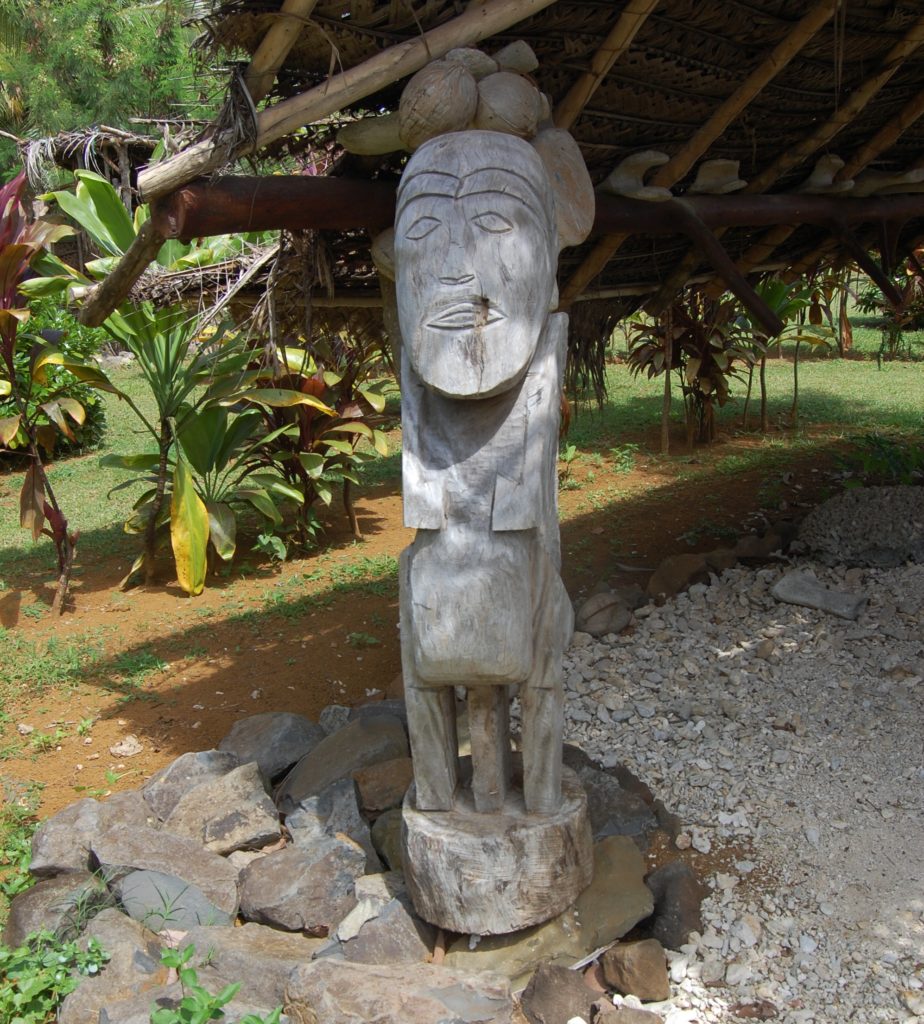
When I met Ngaa in autumn 2015 he had just returned from visiting museums in Munich, Barcelona and Cambridge to view these Aitutakian artefacts… Including tiki such as the tattooed female figure of a high-ranking founding ancestor of Aitutaki, which was displayed in the ‘Treasures Of Oceania’ exhibition in the Royal Academy in London in 2018.
It was obvious that having seen these artefacts from his own culture meant a great deal to Ngaa: but when I asked him if he wanted them to be returned to the Cook Islands he sadly replied that there seemed to be little political will to bring such cultural treasures home and conserve them properly. All the more impressive that Ngaa and his family (such as mother, pictured below teaching us how to weave the palm-leaf roofing used on huts) are doing such important and vital work, bringing their culture and history alive and passing on its creativity, strength and stories to the next generation.
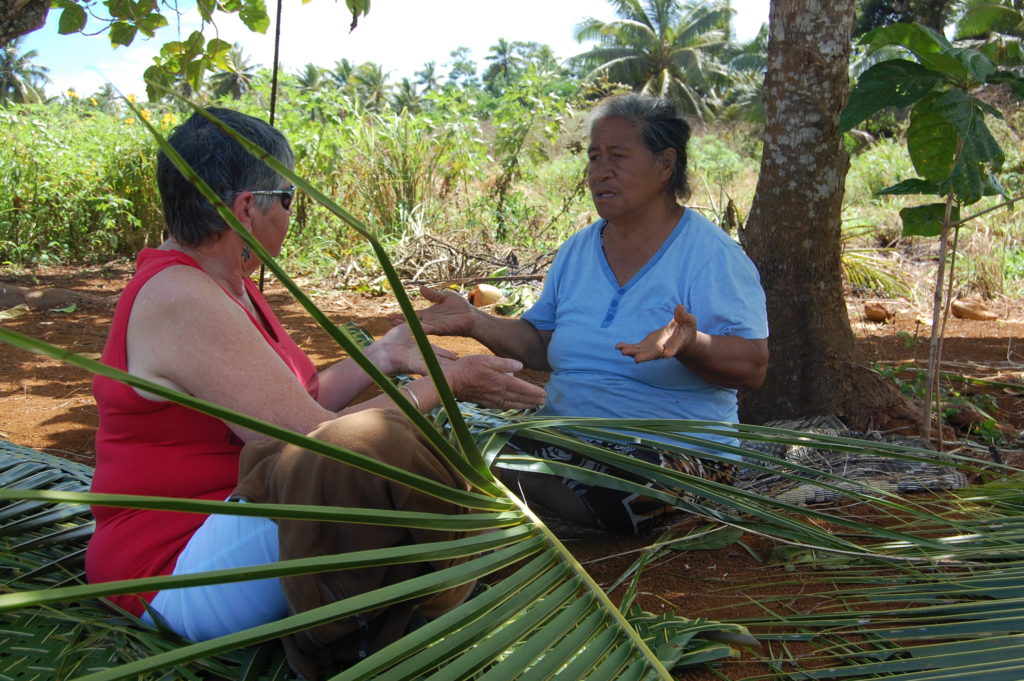
Despite a lack of official support, Ngaa is working hard to bring Aitutaki’s history and culture to the schoolchildren and young people of the island, as well as sharing it with visiting tourists. He hopes to continue excavating local sites, researching artefacts taken into private collections, and collecting and singing the ancient chants and songs that form the oral history of his people. (There were at least three hundred chants, for everything from harvesting and cooking to gardening and hunting.) The language spoken on Aitutaki is unique, as on other islands: there are 15 different island languages in this South Pacific nation. I learned a few phrases: Po’ pongi (Good morning, “sun rise”); Ae’ i au (Good afternoon, “sun dimming”); and Pae’ ae koe (How are you).
I found Ngaa’s knowledge fascinating, his intentions inspiring, and his passion infectious. As someone who works in oral tradition (leading community choir singing) and outdoor teaching with children and young folks, my heart really warmed to him. I hope that his work continues to develop successfully, and his mission to keep his people’s culture alive flourishes. And if you want to support his work, he will shortly be publishing a book about Aitutaki’s history (working title: Food For Flame), which I will include a link for here as soon as it becomes available.
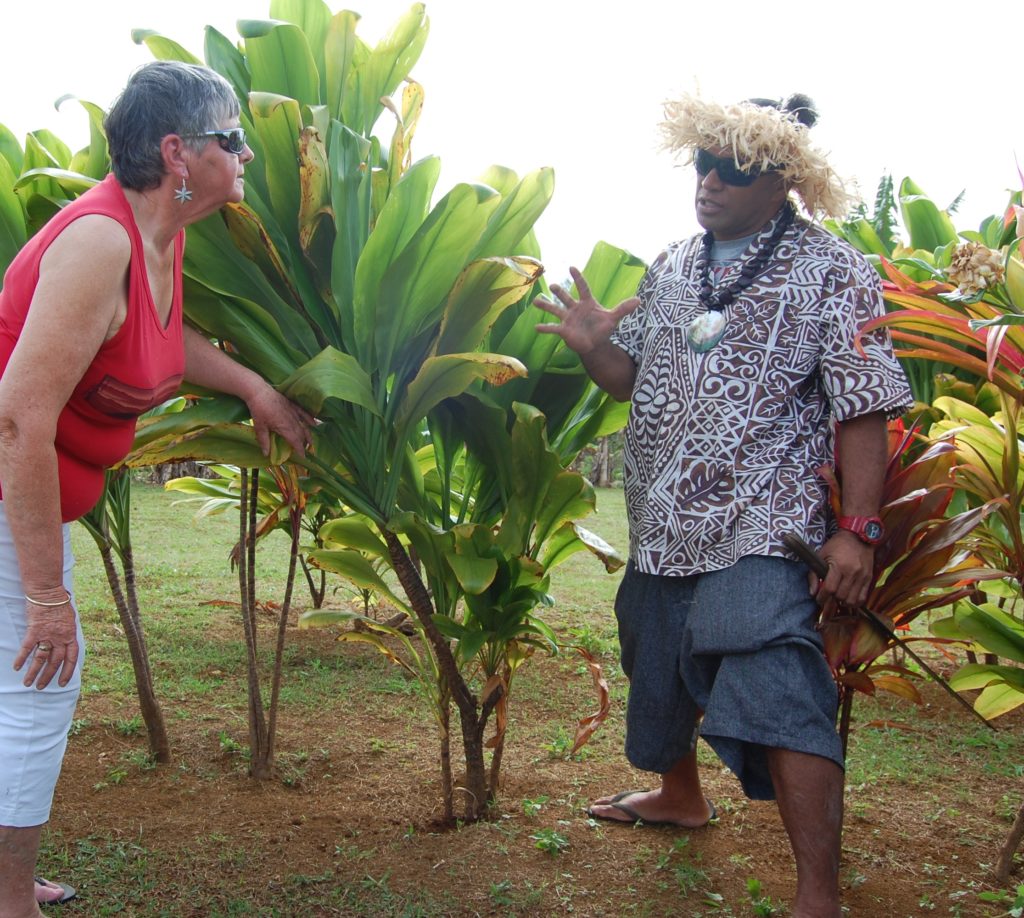
Back at Matriki that evening I celebrated my lovely day by joining Trevor and Tracey and some other tourist visitors for a shared meal on the beach. The conversation took an unexpected turn, when someone mentioned that there was a tsunami warning for the South Pacific region, after a big earthquake that day in Chile. Tracey confirmed she’d received several email tsunami alerts, though to put it in context Trevor told us they receive one every few weeks on average. In the resort next door the guests had apparently been freaking out and had to be reassured by the resort manager going round to calm things down… But at Matriki there was a pretty laid-back attitude, with discussion of a possible six-foot wave arriving between midnight and 1.00 AM (to put this in context, Tracey did point out that this would mean the beach huts would be in the sea!).
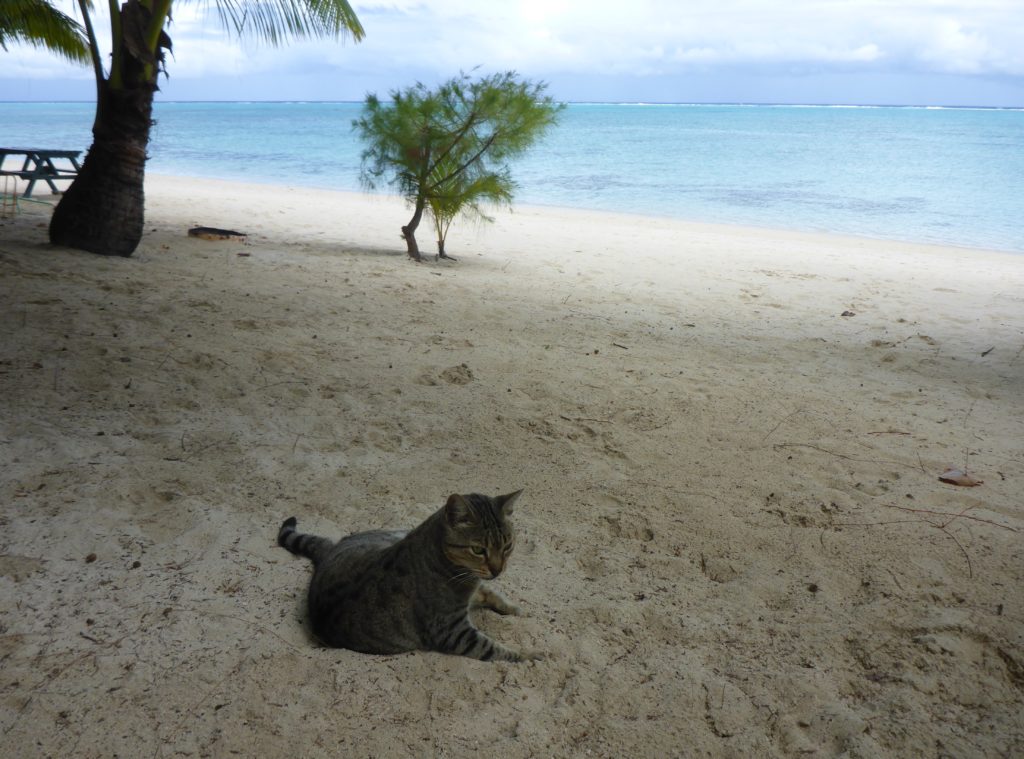
Conversation turned to folkloric natural signs of impending tsunami: the sea drawing back, banana tree shoots bending over, crabs heading inland or climbing up trees. Suddenly we all got very interested in knowing where the Matriki cats were; but it turned out that Tuxi was perched contentedly on a chair, Bubbles was sat on the beach gazing out to sea, and Marmalade was fast asleep in a flowerbed. Finding this weirdly reassuring, we all agreed to adjourn to bed. Tracey said that if any of us heard anything (i.e. the roar of an approaching tsunami) to yell and alert everybody else and then head straight to the house: from where she and Trevor would put us in the pick-up and drive to a high point (the Piraki viewpoint).
It felt surreal to be going to bed, with the knowledge that a tsunami was possibly rolling across the Pacific Ocean towards us. In our dinner table conversation we’d all studiously avoided mentioning the Boxing Day tsunami of 2004, which killed an estimated 228,000 people in countries around the Indian Ocean… But I’m pretty sure that more than one of us was thinking about it. All those ‘Tsunami Evacuation Route’ signs I’d seen on Rarotonga didn’t seem funny any more.
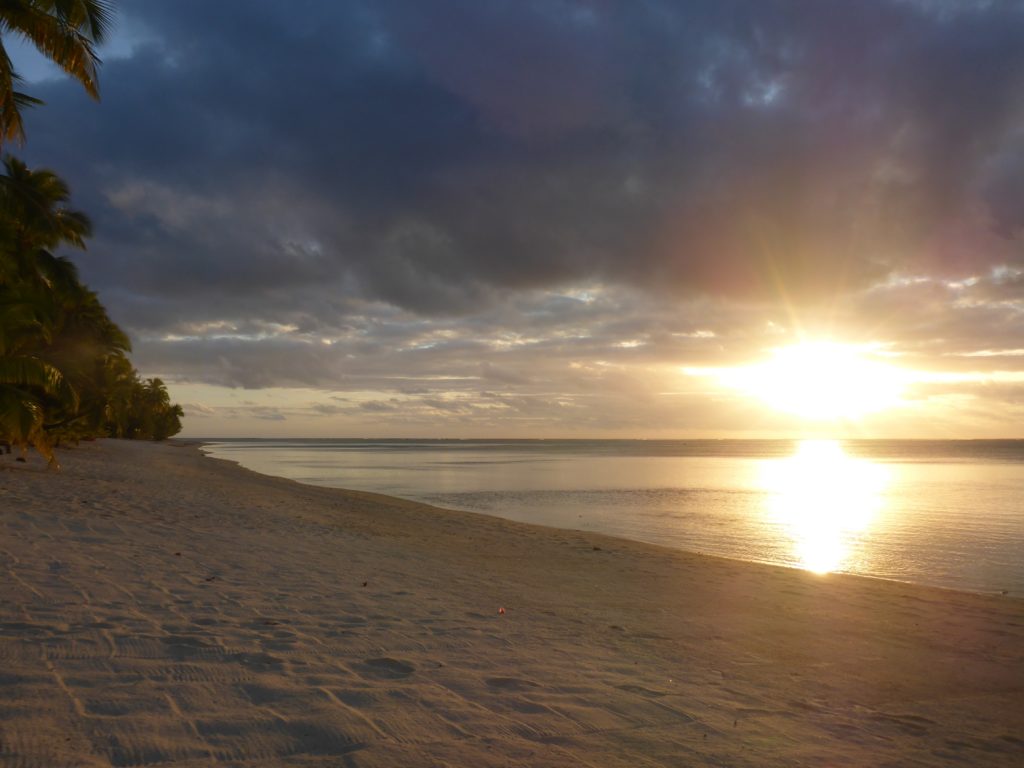
As so often happens in times of stress, my sensible head switched itself on: I filled my backpack with essentials, ready to be grabbed should I need to evacuate in a hurry. Obvious stuff like water, snacks, first aid kit, medicines, lighter, penknife, headtorch, mobile phone, passport and wallet all went in… Plus my journal, a carved stone heart, and a copy of Peace Is Every Step by Thich Nhat Hanh. I curled up in bed dressed for action and lay there in the dark listening intently to the sound of the sea breaking on the reef, and wondering if the waves sounded like they were getting bigger. But the human mind is good at accommodating what it can’t do anything about: I trusted in the good folks of Matriki and my preparations, sent a metta prayer out into the universe, and fell asleep…
…And woke the next morning to a beach undisturbed by giant waves, where the cats rolled in the warm sand and stalked fish in the shallows. My last full day on Aitutaki, which I commemorated by going for a farewell snorkel in the lagoon to say goodbye to all the little fishies and corals. As evening fell I watched another glorious sunset, before going to watch a resort Island Night from the beach nearby. Lots of drumming and singing and fire staff dancing, completely inauthentic (most of the this entertainment style is imported from Hawaii) but lots of enthusiasm. I enjoyed it, but found myself thinking of Ngaa and his mission to keep the authentic culture of his people on Aitutaki alive.
I know that I would be leaving Aitutaki the following morning, to continue on my travels to the smaller island of Atiu… And I wondered if I would ever return to this beautiful, complex, diverse place; to its warm, friendly, proud, intelligent people. I hope that the future for Aitutaki holds safe and sustainable lives, not so dependent on tourist cash; safety from cyclone and tsunami and climate change; and deep connection with the rich legacy of their past and their culture. Kia manuia!

I write, photograph, teach and sing about the world, for the world. If you enjoy my work and would like to help support me to keep on doing it, please consider buying me a coffee at KoFi, or making a regular donation via Patreon. The links are here below: much gratitude to all those who have encouraged and supported me thus far. <3
Rowanleaf on KoFi (one-off donations)
Rowanleaf on Patreon (monthly donations)
Coming up next time, in South Pacific Adventure part 7:
Ancient coral cliffs and dodgy landings; swimming in caves and spotting birds that live in the dark: exploring Atiu, wild little gem of the Cook Islands.

